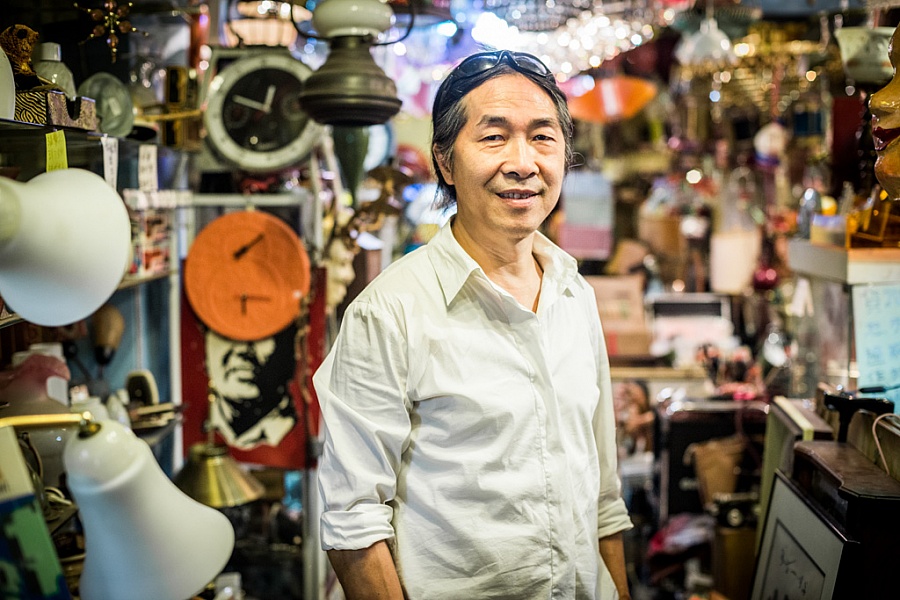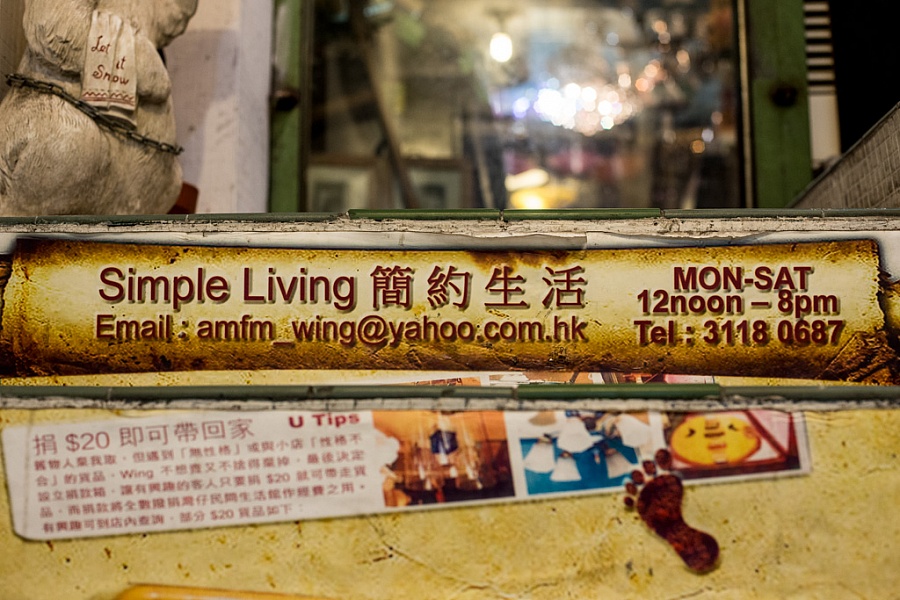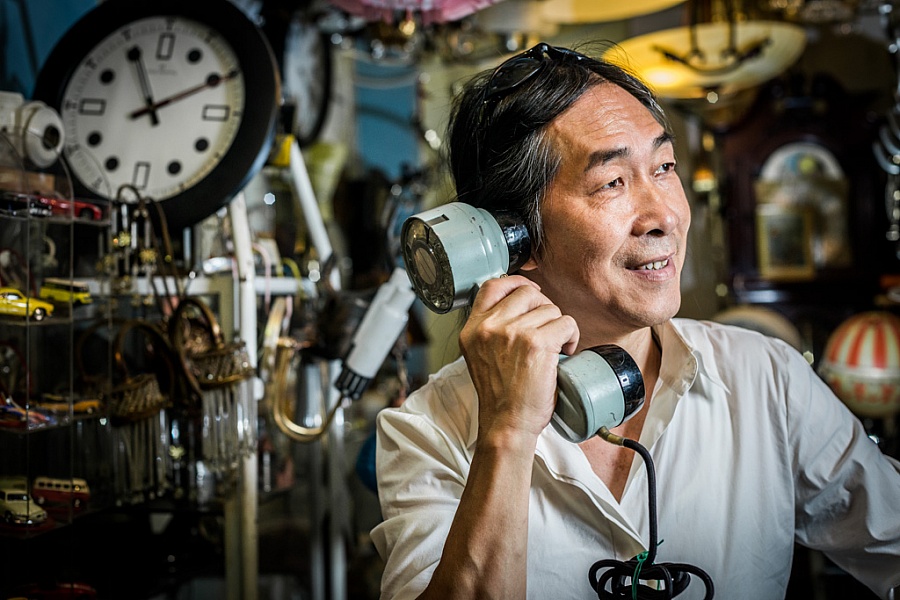My trip down cluttered memory lane should have set me back a couple hundred dollars. That outlay probably didn’t reflect the true worth of what I found: a Hong Kong travel map printed in the 1950s, a black-and-white postcard of a now-demolished cinema that once stood on the corner of Castle Peak Road and Tonkin Street in Sham Shui Po, and a draft copy of China’s 1954 constitution. But Ah Wing told me not to pay him. “Put the money into the letter box that you couldn’t take your eyes off the first time you came,” he said. The silver rectangular letterbox is of the kind that hung on every household door in the old days. Ah Wing told me it’s a donation box for Blue House because he’s one of their volunteers. Therefore, like many local history lovers before me, my retro shopping has contributed to the regeneration of the Grade I listed building on Stone Nullah Lane, opposite the old Wan Chai Market.
The ponytail-wearing treasure keeper is known to his friends as Ah Wing (affectionate short for his real name, Fung Wing-kuen) or simply, Long Hair. He’s kept his hair long ever since he found out many in this city associate long locks with designers. As he used to work in the garment industry, that image proved to be very useful. The story goes that around the year 2000, Ah Wing started to grow his hair long, not out of any conscious desire for a style makeover, but just because he couldn’t be bothered to go to the hairdresser’s. The millennial accident would soon transform his fortunes as previously uninterested suppliers suddenly showed him huge respect because of his radical new look. Today, Ah Wing continues to lead different identities. For some, he owns and runs a bar in Central; for others, he’s an atypical, generous businessman who’s built up a popular vintage store on Lockhart Road. This story on Ah Wing is about his vintage business, Simple Living.
Ah Wing’s time capsule is on the mezzanine floor of a six-storey walk-up building in the middle of Wan Chai. The 600-square-feet shop space is bursting at the seams with all sorts of vintage items: lamps, chandeliers, clocks, fans, telephones and posters. Cabinets and shelves groan under the weight of wallets, handbags, tea sets, glasses, documents, books, photos and a mélange of metal tools. A circular, half-foot wide path amid the almighty jumble of collectibles is the only route to navigate the store. The items strewn around the store represent only a small proportion of Ah Wing’s entire collection. He keeps four warehouses, which range from 200 to over 1,000 square-feet, where he stores the bigger pieces such as suitcases, wardrobes, armchairs, cinema chairs, barber chairs and cha chaan teng furniture. Whenever I doubt if he can actually remember everything that’s piled up in his collection, he’ll say, “Tell me what you want, I will find them for you.”
Ah Wing’s ability to recover the past is not to be disputed. After the vintage Paa Kung Cafe in To Kwa Wan folded early last year because of poor business, some people decided to restore an old-style cha chaan teng at the same location. But they didn’t have the classic cha chaan teng furniture to recreate the nostalgic dining atmosphere, so Ah Wing donated the necessary furniture and decorations to them.
On another occasion, Ah Wing gave two traditional Chinese rice bowls with hand painted rooster prints to a Taiwanese visitor, also for free, and he wrapped the gift in a newspaper from the 1950s. The old gems that Ah Wing gives away would have ended up in one of the city’s rapidly saturating landfills had he not saved them from abandoned old buildings and the bulldozers that inevitably follow.
When Ah Wing started his business in 2004, he sold bric-a-brac – mostly vintage clocks and cameras – that he had been collecting since the mid-70s when he was working in film crews. “Buying antiques for the set was part of my work. Gradually I developed this habit of going to the antique shops on Hollywood Road,” he said. However, he left the film industry at its heyday towards late 80s after realising that the work no longer interested him. “I kept looking at my watch then I knew I was getting bored and it was time to leave.”
Originally, he planned to sell off his entire vintage collection and leave Hong Kong for a long holiday. But the plan didn’t work out, his stocks kept growing and today he has a second store in a Kwun Tong industrial building where he sells the bigger pieces that he’s accumulated, such as dining tables, chairs and cabinets.
Additions to Ah Wing’s ever-expanding collection come from two major sources: rubbish from vacated old buildings awaiting redevelopment, and knick-knacks that people can no longer keep largely because their homes are too small for anything that is of no practical domestic use.
Over the past eight years, Ah Wing has gathered a group of friends who shares the same passion for discovering and keeping vintage items. They inform each other every time a cinema has closed down and is facing demolition. Similarly, they exchange information about aged buildings that have been vacated because of redevelopment. In the beginning, their usual way of ‘excavation’ was breaking into these buildings. Now, they choose sites where they know the security guards, but they’d always operate individually. When Ah Wing goes to a vacated building, he explains to the guards that he is a collector and that, in his eyes, abandoned household items are not rubbish and he will for pay for what he takes away.
When he’s inside abandoned buildings, he looks for items that can shed light on a previous era in Hong Kong. “I am curious about how people lived in the past,” he said. So when he visited a campus that’s been vacated by a leftist secondary school, he took home piles of documents, old magazines and textbooks rather than abandoned desks and chairs. From the documents, he learned about a scholarship programme for the poor in Hong Kong and those living on the mainland to study in the school. As we went through the old textbooks, I was amused by the positive spin they placed on the Cultural Revolution.
Ah Wing has developed a name for having an extensive network of clients and being helpful to the small collectors. He’s always willing to receive people whose collections have outgrown their homes, or that their children aren’t interested to inherit the relics. He either buys from these individuals, or asks them to photograph their collection and stick the pictures on the wall in his store so customers interested in the items can contact them directly. Again, he doesn’t charge for his service. “I have clients who pay a lot for my goods, and I don’t need much money,” he said.
Indeed, Ah Wing tries to keep a frugal lifestyle. He lives on Lamma Island, travels to work by ferry and bus, and always takes his lunch at the same cheap food stall in Lockhart Road Indoor Market which is only a minute’s walk from his store. He likes to repeat that he spends less than HK$100 a day.
The owner of Simple Living really practises what it says on the tin.
Ah Wing’s Q&A
Q: What do you like the most about Hong Kong?
A: I like Hong Kong the most because I have met many generous people in this city. They are helpful to those in need. The help they give is not just in the form of money, they think about how they can help others realise their dreams. That’s one of the reasons why I love this shop of mine because here, I come across many of these generous people. They come here, we chat, and we become friends. I am proud of what these people are doing. I am also trying to be helpful.
Q: What do you dislike the most about Hong Kong?
A: Hypocrites. People who like to brag about their generosity, the fact is they are loud yet they hardly do anything.
Q: What does Hong Kong need to do for it to be a sustainable city?
A: Take action to help others realise their dreams, especially those of young people. They don’t necessarily need our money. There are young music lovers and what they need is a place where they can perform and meet others who share the same passion. If we have space, why don’t we turn it into a platform for them? The bar that I run with my friends gives musicians a space to perform, so it’s one small contribution towards that end.







